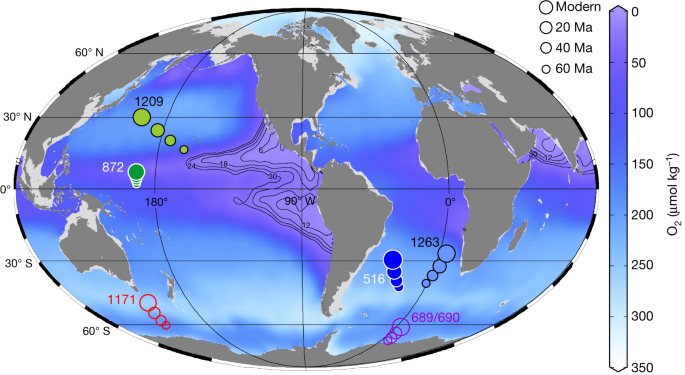過去の温暖期には、外洋の酸素欠乏帯が縮小していた。 Earth’s past warm periods witnessed the shrinkage of the open ocean’s oxygen-deficient zones.
2022-09-02 マックス・プランク研究所
ドリルコアは、木の年輪と同じように、過去の環境状態を知ることができる。なかでも堆積物層は、過去の海の酸素量に関する情報を提供してくれる。これは、かつて海面に生息していた有孔虫などの微生物が、その骨格を海底に沈め、堆積物の一部となったためである。動物プランクトンはその生涯で窒素などの化学元素を吸収し、その同位体比は環境条件によって変化する。酸素不足の環境では、バクテリアによる脱窒が起こる。これは、栄養塩である硝酸塩をバクテリアによって化学的に還元し、窒素分子(N2)を生成するプロセスです。バクテリアは水中の軽い同位体を好んで吸収するため、海洋でバクテリアが活動していた時期には、軽い14Nと重い15Nの比率が変化していた。この同位体比の変化から、以前の酸素欠乏地帯の範囲を特定することができる。
今回の研究では、新生代の2つの温暖期(約1600万年前の中新世気候最適期と約5000万年前の始新世気候最適期)には、高緯度と低緯度の温度差が現在よりもずっと小さかったことも明らかにされた。
<関連情報>
- https://www.mpg.de/19158609/0902-chem-ocean-oxygenation-152990-x?c=2249
- https://www.nature.com/articles/s41586-022-05017-0
新生代の温暖期における海洋酸素濃度の上昇 Enhanced ocean oxygenation during Cenozoic warm periods
Alexandra Auderset,Simone Moretti,Björn Taphorn,Pia-Rebecca Ebner,Emma Kast,Xingchen T. Wang,Ralf Schiebel,Daniel M. Sigman,Gerald H. Haug & Alfredo Martínez-García
Nature Published:31 August 2022
DOI:https://doi.org/10.1038/s41586-022-05017-0

Abstract
Dissolved oxygen (O2) is essential for most ocean ecosystems, fuelling organisms’ respiration and facilitating the cycling of carbon and nutrients. Oxygen measurements have been interpreted to indicate that the ocean’s oxygen-deficient zones (ODZs) are expanding under global warming1,2. However, models provide an unclear picture of future ODZ change in both the near term and the long term3,4,5,6. The paleoclimate record can help explore the possible range of ODZ changes in warmer-than-modern periods. Here we use foraminifera-bound nitrogen (N) isotopes to show that water-column denitrification in the eastern tropical North Pacific was greatly reduced during the Middle Miocene Climatic Optimum (MMCO) and the Early Eocene Climatic Optimum (EECO). Because denitrification is restricted to oxygen-poor waters, our results indicate that, in these two Cenozoic periods of sustained warmth, ODZs were contracted, not expanded. ODZ contraction may have arisen from a decrease in upwelling-fuelled biological productivity in the tropical Pacific, which would have reduced oxygen demand in the subsurface. Alternatively, invigoration of deep-water ventilation by the Southern Ocean may have weakened the ocean’s ‘biological carbon pump’, which would have increased deep-ocean oxygen. The mechanism at play would have determined whether the ODZ contractions occurred in step with the warming or took centuries or millennia to develop. Thus, although our results from the Cenozoic do not necessarily apply to the near-term future, they might imply that global warming may eventually cause ODZ contraction.



